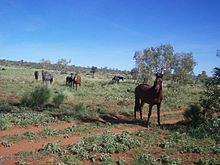
Back Брамбі Byelorussian Brumby Czech Brumby (Pferd) German Brumby Spanish Brumby Basque Brumby Finnish Brumby French סוס ברומבי HE Brumby-ló Hungarian Brumby Italian
 Brumbies near the Sandover Highway in the Northern Territory, 2006 | |
| Country of origin | Australia |
|---|---|
A brumby is a free-roaming feral horse in Australia. Although found in many areas around the country, the best-known brumbies are found in the Australian Alps region. Today, most of them are found in the Northern Territory, with the second largest population in Queensland. A group of brumbies is known as a "mob" or "band".[1]
Brumbies are the descendants of escaped or lost horses, dating back in some cases to those belonging to the early European settlers. Today they live in many places, including some National Parks, notably Alpine National Park in Victoria, Barrington Tops National Park and Kosciuszko National Park in NSW, and Carnarvon National Park in Queensland. Occasionally they are mustered and tamed for use as campdrafters, working stock horses on farms or stations, but also as trail horses, show horses, Pony Club mounts and pleasure horses.[2] They are the subject of some controversy – regarded as a pest and threat to native ecosystems by environmentalists and the government,[3][4] but also valued by others as part of Australia's heritage, with supporters working to prevent inhumane treatment or extermination, and rehoming brumbies who have been captured.[5]
There are no known predators of feral horses in Australia, although it is possible that dingoes or wild dogs occasionally take foals. On average, 20% of the feral horse population dies each year, mainly from drought, poisonous plants and parasites. Few feral horses reach 20 years of age. The maximum possible rate that feral horse numbers can increase is 20–25% per year.[6][7]
- ^ Mellor, Leonie (19 September 2018). "Australia's wild desert horses: 'This environment tests them to their limits'". ABC 7.30 (News Report). Archived from the original on 16 November 2021. Retrieved 6 November 2019.
...wild horses, in what's referred to as bands. Groups of up to a dozen with a protective stallion...
- ^ Dobbie, W. R., Berman, D. M., & Braysher, M. L. (1993). Managing Vertebrate Pests: Feral horses. Canberra: Australia Government Publishing Service.
- ^ Cite error: The named reference
AGDEH 2004was invoked but never defined (see the help page). - ^ Holland, Malcolm (15 March 2010). "Guns cocked as brumbies run wild". Herald Sun. Retrieved 20 December 2010.
- ^ Foster, Helen and Digby (2010). "The Guy Fawkes Heritage Horse Association Inc". Dorrigo, NSW: self. Retrieved 4 January 2010.
- ^ Csurhes, Steve; Paroz, Gina; Markula, Anna (2016), Invasive animal risk assessment: Feral horse, Equus caballus (PDF), Department of Agriculture and Fisheries: Biosecurity Queensland
- ^ Malone, Ursula (12 January 2021). "New survey supports need to cull more of Kosciuszko's wild horses, state government says". ABC News. Retrieved 16 February 2021.
© MMXXIII Rich X Search. We shall prevail. All rights reserved. Rich X Search